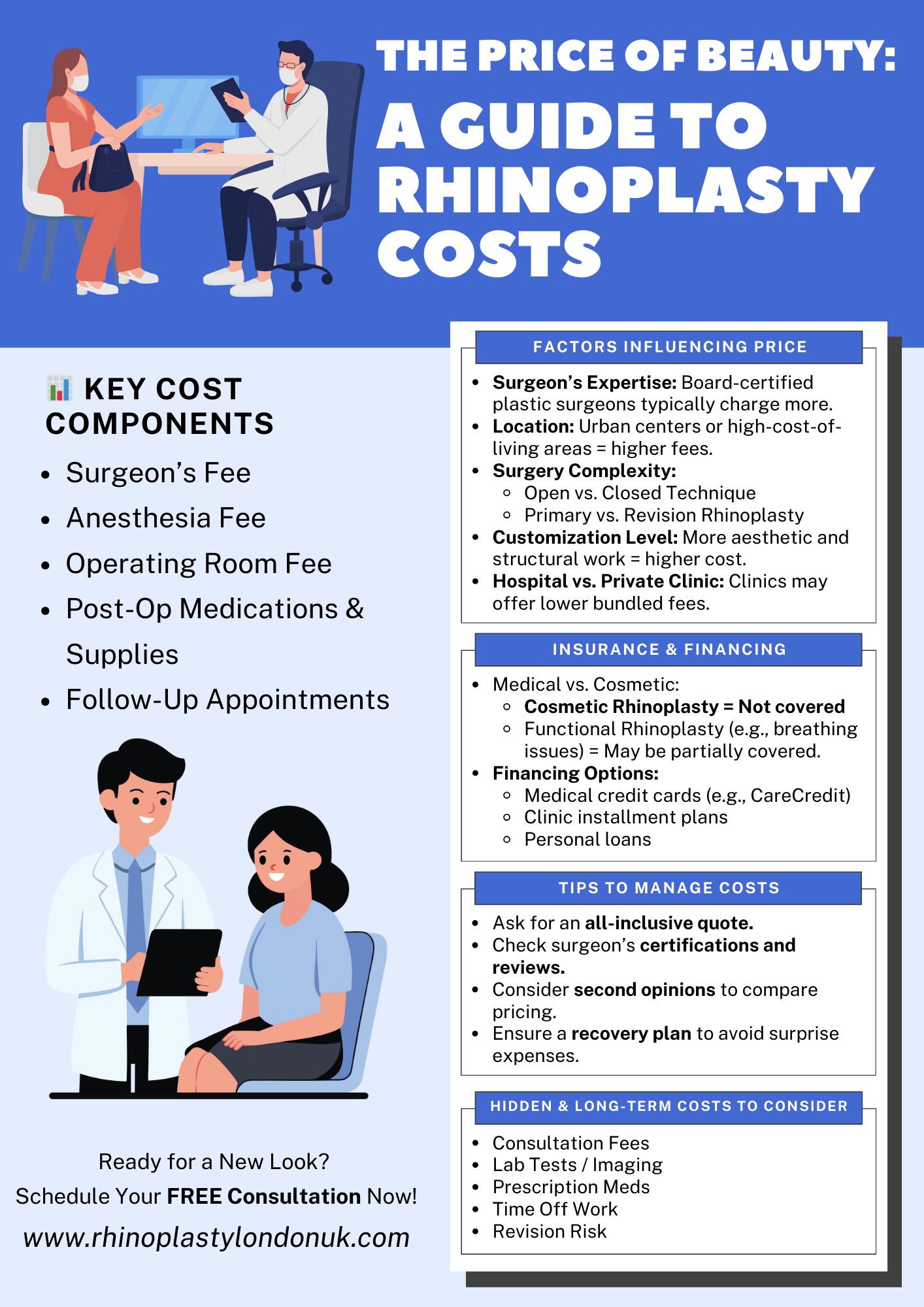If you’re considering nose rhinoplasty, you might be wondering whether your insurance will cover it. This procedure, often referred to as a nose job, can be performed for both cosmetic and medical reasons.
Understanding how insurance companies view rhinoplasty and the factors that influence coverage can help you navigate this complex topic. In this article, we’ll explore the ins and outs of insurance coverage for nose rhinoplasty, the costs involved, and what to expect during the process.
Key Takeaways
-
Nose rhinoplasty can be covered by insurance if deemed medically necessary.
-
Insurance coverage varies by policy, so it’s crucial to check your specific plan.
-
Documentation of medical necessity is often required for claims approval.
-
Costs for rhinoplasty can vary significantly based on the complexity of the procedure.
-
Consulting with both your surgeon and insurance provider is essential for understanding coverage options.
Understanding Nose Rhinoplasty Coverage

What Is Nose Rhinoplasty?
Rhinoplasty, often called a surgical nose job, is a surgical procedure designed to reshape the nose. It’s more complex than many people think, mainly because the nose is a tricky 3D shape right in the middle of your face.
Even small changes can make a big difference to how it looks and works. The upper bit of your nose is bone, and the lower part is cartilage, and rhinoplasty can tweak either, or both, along with the skin.
Why Is Nose Rhinoplasty Performed?
People get rhinoplasty for all sorts of reasons. Some want to change the size or shape of their nose to improve their appearance. Others need it to fix problems caused by an injury, correct a birth defect, or even help them breathe better.
It’s not a simple operation, and surgeons tailor it to each person’s needs.
Common Reasons for Insurance Coverage
Whether your insurance covers rhinoplasty really depends on why you’re having it done. Generally, if it’s purely for cosmetic reasons, you’re unlikely to get coverage. However, if it’s to correct a breathing problem or fix damage from an accident, there’s a better chance your insurance will help.
It’s always best to check with your insurance company beforehand to see what they’ll cover. Getting written confirmation is a smart move, so you know where you stand before going ahead with the operation.
Insurance Policies and Nose Rhinoplasty
How Insurance Companies View Rhinoplasty
So, how do insurance companies actually see rhinoplasty? Generally, they split it into two categories: medically necessary and cosmetic. If it’s purely to change the appearance of your nose, it’s usually considered cosmetic and won’t be covered.
However, if it’s to fix breathing problems or correct damage from an injury, it might fall under the medically necessary umbrella. It really depends on the specifics of your policy and the reason for the surgery.
Types of Coverage Available
Okay, let’s talk about the types of coverage you might find. It’s not always a simple yes or no situation. Here’s a breakdown:
-
Full Coverage: This is rare, but it happens. Usually, it’s when the rhinoplasty is deemed essential for correcting a functional issue, like a severely deviated septum causing breathing difficulties.
-
Partial Coverage: More common. The insurance might cover the part of the surgery that addresses a medical issue but not the cosmetic aspects. For example, fixing a deviated septum while also slightly reshaping the nose might only have the septum part covered.
-
No Coverage: Unfortunately, this is the most frequent scenario for purely cosmetic procedures.
Factors Influencing Coverage Decisions
Loads of things can affect whether your insurance will pay out. Here are a few key ones:
-
The Reason for the Surgery: As we’ve said, medical necessity is key.
-
Your Specific Policy: Each policy is different.
-
Pre-existing Conditions: Some policies might not cover issues related to pre-existing conditions.
-
Prior Authorisation: Getting approval before the surgery is often essential. Don’t skip this step!
It’s always a good idea to get pre-authorisation from your insurance company before undergoing any procedure. This way, you’ll know exactly what’s covered and what isn’t, avoiding any nasty surprises later on.
Eligibility for Insurance Coverage
Medical Necessity vs. Cosmetic Reasons
Insurance companies are way more likely to cover a nose job if it’s deemed medically necessary.
What does that even mean? Well, think breathing problems, fixing damage from an accident, or correcting a birth defect. If you’re getting a rhinoplasty purely to change the way your nose looks, you’re probably going to have a harder time getting coverage.
Documentation Required for Claims
Now comes the fun part: paperwork. You’ll need to gather all sorts of documentation to support your claim. Think doctor’s notes, imaging results (like X-rays or CT scans), and letters from specialists.
Basically, you need to prove to the insurance company that this isn’t just about vanity. The more evidence you can provide, the better your chances of getting approved. Here’s a quick list of what you might need:
-
Referral from your GP
-
Detailed report from an ENT specialist
-
Pre-operative assessment results
Getting all your ducks in a row before surgery can save you a massive headache later on. Make sure everything is properly documented and submitted correctly. It’s a bit of a faff, but it’s worth it in the long run.
Consultation with Insurance Providers
Honestly, the best thing you can do is have a proper chat with your insurance provider before you even book the surgery. Ask them directly what their policy is on rhinoplasty, what documentation they need, and what the chances are of getting approved.
It’s better to know where you stand from the start rather than getting a nasty surprise later on. Plus, they might have some helpful tips or suggestions that you wouldn’t have thought of. Don’t be afraid to ask loads of questions – that’s what they’re there for!
Cost Considerations for Nose Rhinoplasty
Average Costs of Nose Rhinoplasty
One of the first things on your mind is probably, “How much is this going to set me back?”. Well, the cost of rhinoplasty can vary quite a bit. It depends on a few things, like the complexity of the surgery, where you’re getting it done, and the surgeon’s experience.
In the UK, you might be looking at anywhere from £4,000 to £7,000. This is just a rough estimate, though. Always get a proper consultation and a detailed quote.

Financing Options for Surgery
Right, so the cost is a bit daunting? Don’t worry, there are ways to make it more manageable. Loads of people explore different financing options to make their dream nose a reality. Here are a few ideas:
-
Medical loans: Some companies offer loans specifically for medical procedures.
-
Payment plans: Some surgeons offer their own payment plans, allowing you to spread the cost over time.
-
Credit cards: While not ideal due to interest rates, a credit card could be an option if you can pay it off quickly.
It’s worth doing your homework and comparing different options to find the one that best suits your budget. Don’t be afraid to ask your surgeon’s office about payment plans or financing options they might offer. They’re used to these conversations and can point you in the right direction.
Navigating the Insurance Process
Before you even think about booking that surgery, there are a few things you really need to do. Skipping these steps could mean your claim gets denied, and nobody wants that!
-
Contact your insurance provider: This is the most important step. Speak to a representative and ask detailed questions about your policy’s coverage for rhinoplasty. Get everything in writing if possible. Don’t just assume something is covered; confirm it.
-
Get a pre-authorisation: Some insurance companies require pre-authorisation before you undergo any procedure. This means they need to approve the surgery beforehand. It’s better to get this sorted early to avoid surprises later.
-
Gather all necessary documentation: This includes your medical records, doctor’s notes, and any other information that supports the medical necessity of the procedure. The more evidence you have, the stronger your case will be.
How to File an Insurance Claim
Okay, you’ve had the surgery, and now it’s time to file that claim. Here’s how to do it right:
-
Obtain the claim form: Get the correct claim form from your insurance provider. You can usually find this on their website or request it from a representative.
-
Fill out the form accurately: Make sure you complete every section of the form with accurate information. Any errors or omissions could delay or invalidate your claim.
-
Attach all supporting documents: Include copies of your medical records, doctor’s notes, surgical reports, and any other relevant documentation. The more information you provide, the better.
-
Submit the claim: Send the completed form and supporting documents to your insurance provider. Keep a copy for your records.
What to Do If Your Claim Is Denied
It’s frustrating, but claim denials happen. Don’t lose hope! Here’s what you can do:
-
Understand the reason for denial: Find out exactly why your claim was denied. The insurance company should provide a written explanation.
-
Review your policy: Double-check your policy to see if the denial is justified. Sometimes, denials are based on misunderstandings or misinterpretations of the policy.
-
Appeal the decision: You have the right to appeal the denial. Follow the insurance company’s appeals process, providing any additional information or documentation that supports your case. Persistence is key here.
-
Seek external review: If your appeal is unsuccessful, you may be able to seek an external review from an independent organisation. This can provide a fresh perspective on your claim.
Alternatives to Traditional Insurance Coverage
So, your insurance isn’t playing ball? Don’t lose hope just yet! There are other ways to manage the costs of your nose rhinoplasty. Let’s explore some options that might just work for you.
Health Savings Accounts (HSAs)
If you’ve got a high-deductible health insurance plan, a Health Savings Account (HSA) could be a great shout. It’s basically a savings account specifically for healthcare costs, and the money you put in is tax-free.
You can use the funds in your HSA to pay for eligible medical expenses, including rhinoplasty, if it qualifies. The best part? The money in your HSA rolls over year after year, so you don’t lose it if you don’t use it all in one go.
Flexible Spending Accounts (FSAs)
Similar to HSAs, Flexible Spending Accounts (FSAs) allow you to set aside pre-tax money for healthcare expenses. However, FSAs are usually offered through your employer, and there’s often a “use-it-or-lose-it” rule, meaning you need to spend the money within a certain timeframe (usually a year) or you’ll forfeit it.
Still, if you know you’re going to have significant medical expenses in the near future, an FSA can be a smart way to save on taxes.
Payment Plans Offered by Surgeons
Many surgeons understand that rhinoplasty can be a significant financial commitment, and they’re willing to work with patients to make it more affordable. Some surgeons offer in-house payment plans, allowing you to spread the cost of the surgery over several months or even years.
Others partner with medical financing companies that specialise in providing loans for healthcare procedures. It’s always worth asking your surgeon about payment plan options – you might be surprised at what’s available.
Exploring these alternatives can make rhinoplasty more accessible. Don’t hesitate to investigate each option thoroughly to find the best fit for your financial situation. Remember, a bit of research can go a long way in making your desired procedure a reality.
Consulting with a Specialist

Choosing the right surgeon is a big deal when you’re thinking about rhinoplasty. It’s not just about finding someone with the qualifications, but also someone you trust and feel comfortable with. Let’s look at what’s involved.
Choosing the Right Surgeon
Finding the right surgeon is more than just picking the first name you see. You want someone who specialises in rhinoplasty, has plenty of experience, and a good track record. Check their credentials, read reviews, and look at before-and-after photos of their previous patients.
It’s also a good idea to see if they have specific expertise in the type of rhinoplasty you’re considering, whether it’s for cosmetic or functional reasons.
Preparing for Your Consultation
Before you even set foot in the surgeon’s office, do your homework. Write down all the things you want to change about your nose, and any breathing problems you might have. Gather your medical history, including any previous surgeries or allergies. The more prepared you are, the more productive your consultation will be.
Questions to Ask Your Surgeon
During your consultation, don’t be shy about asking questions. Here are a few to get you started:
-
What experience do you have with rhinoplasty?
-
Can I see before-and-after photos of your patients?
-
What are the risks and potential complications of the surgery?
-
What kind of anaesthesia will be used?
-
What is the recovery process like?
-
How much will the procedure cost?
It’s important to remember that a good surgeon will take the time to listen to your concerns, answer your questions thoroughly, and provide you with realistic expectations about the outcome of the surgery. If you feel rushed or pressured, it might be a sign to look elsewhere.
Conclusion
While rhinoplasty is often seen as a cosmetic procedure, the truth is more nuanced. Insurance may cover part or all of the costs if your surgery is deemed medically necessary—such as correcting a deviated septum, restoring normal breathing, or addressing trauma-related issues. However, purely aesthetic enhancements are typically not covered by most insurance plans.
The best way to determine your eligibility is by having your unique situation evaluated by a professional. If you’ve been wondering whether your nose surgery might qualify for insurance support, it might be worth starting with a pressure-FREE consultation to explore your options and understand the next steps tailored to you.
Frequently Asked Questions
Does insurance cover rhinoplasty?
Sometimes, insurance will cover rhinoplasty, but it depends on the specific policy. If the surgery is deemed necessary for medical reasons, such as fixing breathing problems, it may be covered.
What is rhinoplasty?
Rhinoplasty, often called a nose job, is a surgery that changes the shape of the nose. People get it for cosmetic reasons or to fix problems with breathing.
How much does rhinoplasty cost?
The cost of rhinoplasty can vary widely, but in the UK, it typically ranges from £4,000 to £7,000. This price may not include consultations or follow-up care.
What should I do if my insurance claim is denied?
If your insurance claim is denied, you can appeal the decision. Make sure to gather all necessary documents and communicate clearly with your insurance provider.
Are there risks involved with rhinoplasty?
Like any surgery, rhinoplasty has risks, which can include bleeding, infection, or breathing difficulties. It’s important to discuss these with your surgeon.
How long does recovery take after rhinoplasty?
Recovery from rhinoplasty usually takes about two weeks, but it can take several months for the swelling to fully go down and for the final results to be visible.





